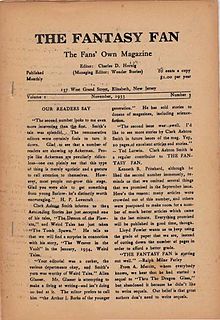Related Research Articles

Shub-Niggurath, often associated with the phrase "The Black Goat of the Woods with a Thousand Young", is a deity in the Cthulhu Mythos of H. P. Lovecraft. The only other name by which H. P. Lovecraft referred to her was "Lord of the Wood" in his story The Whisperer in Darkness.
The Pnakotic Manuscripts is a fictional manuscript in the Cthulhu Mythos. The tome was created by H. P. Lovecraft and first appeared in his short story "Polaris" (1918). They are mentioned in many of Lovecraft's stories, including "The Other Gods" (1933), The Dream-Quest of Unknown Kadath (1926), The Whisperer in Darkness, At the Mountains of Madness (1936), "Through the Gates of the Silver Key", The Shadow Out of Time (1936) and "The Haunter of the Dark". The manuscripts are also referred to by other Mythos authors, such as Lin Carter and Brian Lumley.

Azathoth is a deity in the Cthulhu Mythos and Dream Cycle stories of writer H. P. Lovecraft and other authors. He is the ruler of the Outer Gods.

Tsathoggua is a supernatural entity in the Cthulhu Mythos shared fictional universe. He is the creation of American writer Clark Ashton Smith and is part of his Hyperborean cycle.
The Hyperborean cycle is a series of short stories by Clark Ashton Smith that take place in the fictional prehistoric setting of Hyperborea. Smith's cycle takes cues from his friends, H. P. Lovecraft and Robert E. Howard and their works. Lovecraft wrote to Smith in a letter dated 3 December 1929: "I must not delay in expressing my well-nigh delirious delight at The Tale of Satampra Zeiros [Smith's short story]... [W]hat an atmosphere! I can see & feel & smell the jungle around immemorial Commoriom, which I am sure must lie buried today in glacial ice near Olathoe, in the Land of Lomar!". Soon afterward, Lovecraft included Smith's Tsathoggua in the story "The Mound", ghostwritten for Zelia Reed in December 1929. Lovecraft also mentioned Tsathoggua in "The Whisperer in Darkness", which he began on February 24, 1930. Because Smith in turn borrowed numerous Lovecraftian elements, the cycle itself may be regarded as a branch of the Cthulhu Mythos. In a letter to August Derleth dated 26 July 1944, Smith wrote: "In common with other weird tales writers, I have ... made a few passing references to some of the Lovecraftian deities. My Hyperborean tales, it seems to me, with their primordial, prehuman and sometimes premundane background and figures, are the closest to the Cthulhu Mythos, but most of them are written in a vein of grotesque humor that differentiates them vastly. However, such a tale as "The Coming of the White Worm" might be regarded as a direct contribution to the Mythos.".

"The Haunter of the Dark" is a horror short story by American author H. P. Lovecraft, written between 5-9 November 1935 and published in the December 1936 edition of Weird Tales. It was the last-written of the author's known works, and is part of the Cthulhu Mythos. The epigraph to the story is the second stanza of Lovecraft's 1917 poem "Nemesis".
Many fictional works of arcane literature appear in H.P. Lovecraft's cycle of interconnected works often known as the Cthulhu Mythos. The main literary purpose of these works is to explain how characters within the tales come by occult or esoterica. However, in some cases the works themselves serve as an important plot device. Thus, in Robert Bloch's tale "The Shambler from the Stars", a weird fiction writer seals his doom by casting a spell from the arcane book De Vermis Mysteriis.
De Vermis Mysteriis, or Mysteries of the Worm, is a fictional grimoire created by Robert Bloch and incorporated by H. P. Lovecraft into the lore of the Cthulhu Mythos.
The following characters appear in H.P. Lovecraft's story cycle — the Cthulhu Mythos.
The following tables and lists feature elements of the Cthulhu Mythos, that are often shared between works within that fictional setting.
The Xothic legend cycle is a series of short stories by American writer Lin Carter that are based on the Cthulhu Mythos of H. P. Lovecraft, primarily on Lovecraft's stories "The Call of Cthulhu" and "Out of the Aeons".
A number of supernatural characters appear in the Cthulhu Mythos. While many of these beings have godlike qualities, they do not fit the standard categories. Nonetheless, they are noteworthy for their infrequent or sometimes singular appearances in the mythos.
The Ramsey Campbell deities are fictional supernatural entities created for the Cthulhu Mythos universe of shared fiction by British horror writer Ramsey Campbell.
The Clark Ashton Smith deities are supernatural entities created for the Cthulhu Mythos universe of shared fiction by California-based horror writer and poet Clark Ashton Smith.

"The Other Gods" is a fantasy short story written by American author H. P. Lovecraft, on August 14, 1921. It was first published in the November 1933 issue of The Fantasy Fan.

Gary Clayton Myers is an American writer of fantasy and horror. He is a resident of Fullerton, California.
The Voormis are a fictional race of cave-dwelling humanoids who worship Tsathoggua.
H. P. Lovecraft created a number of deities throughout the course of his literary career, including the "Great Old Ones" and aliens, such as the "Elder Things", with sporadic references to other miscellaneous deities whereas the "Elder Gods" are a later creation of other prolific writers such as August Derleth, who was credited with formalizing the Cthulhu Mythos.
Bibliography of science fiction, fantasy, and nonfiction writer Lin Carter:
References
- ↑ Price, "About The Acolyte of the Flame", The Book of Eibon, p. 357.
- ↑ Price, "About The Light from the Pole", The Book of Eibon, p. 115.
- ↑ Harms, "Aphoom-Zhah", Encyclopedia Cthulhiana , p. 9.
- ↑ Price, "About The Acolyte of the Flame", The Book of Eibon, p. 362.